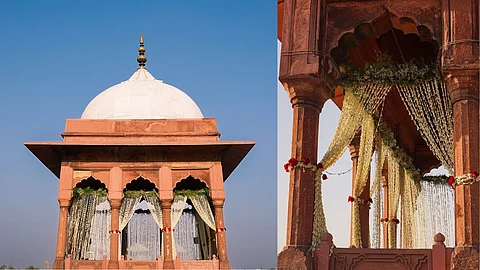
- HOMEGROWN WORLD
- #HGCREATORS
- #HGEXPLORE
- #HGVOICES
- #HGSHOP
- CAREERS
- ABOUT US
- CONTACT US

On the last Friday of Ramadan, as twilight curled softly around Delhi’s skyline, the city's ancient heart pulsed with something both timeless and rare. For the first time in history, the Shah Jahan Darbar of Jama Masjid—Delhi’s most iconic mosque — opened its doors for a private Shahi Iftar. What unfolded wasn’t merely a meal, but a moment suspended in time: an experiential intersection of faith, heritage, and contemporary culture.
Jama Masjid, commissioned by Mughal emperor Shah Jahan between 1650 and 1656, practically floats. over Old Delhi like a dream — its red sandstone minarets, marble domes, and calligraphic inscriptions still resonating with the aesthetic and architectural language of the Mughal empire. Historically, the city's first-choice site for Friday communal prayer, the mosque's actual name. 'Masjid-i Jahān Numā' — the "world-reflecting mosque"— could not have seemed more fitting that evening.
Taken to a 360° viewpoint, a rooftop area that provided not only a panoramic panorama of the Red Fort and Old Delhi's twisted alleys, but a complete arc of the mosque's courtyard below, draining slowly of birds and starting to fill with bodies and expectation.
An event in collaboration with couturier Mayyur Girotra — who recently launched Mahnoor, a collection reviving the North Indian gharara — I couldn’t help but draw parallels between his work and this setting. Like Jama Masjid, Mahnoor is a preservation of grace. Drawing on techniques like zardozi, gota, and aari work, Mayyur’s pieces honour the Nawabi heritage without making it distant. They shimmer with memory, yet pulse with presentness — just like the mosque itself.
“It was humbling and awe-inspiring,” Girotra shares. “Standing in the heart of history, surrounded by the quiet sanctity of Shah Jahan’s Darbar, I felt like time had momentarily stood still. The call to Azaan, the murmur of prayers, and the warmth of shared gratitude made it a night that was not just about feasting but about feeling — feeling connected to something much larger than ourselves. Jama Masjid has always been a place of grandeur, but this evening was about intimacy.”
It was a tableau. Ethereal flower arrangements scented the air, flowing out into the balmy evening air with each gust of wind. Lanterns glowed, marigolds erupted, and the sweet smell of rosewater wafted among them all. An intimate dining alcove, cut into the mosque's own design, had been refashioned as a Dastarkhwan — a quiet, solemn place of communal meals and earthy discourse. The beauty of the night was effortless, a product of rituals centuries old, not show.
“As a designer, I have always drawn inspiration from history,” says Girotra, “but that night, it wasn’t just about inspiration — it was about feeling history come alive. The arches, the intricate jalis, the flickering prayer lamps—each detail felt like a story woven in light and shadow. More than anything, it was a reminder that heritage isn’t something we just preserve, it’s something we live, something that breathes and evolves, much like the silhouettes and textiles I work with.”
And yet, there was beauty everywhere: in the sheen of mirrorwork embroidered into outlines, in the unspoken elegance of guests draped in royal materials, in the quiet wonder of seeing the sun set behind the domes of the mosque as the call to prayer— the Azan— spread across the courtyard. In that pause, hundreds shifted as one. And then, we ate.
Hand to hand, dates were passed along with Rooh afza glasses, haleem bowls, spiced fruits and biryani that steamed — the culinary art of Ramadan as observed through the ages and spaces. More beautiful was the intimacy: there was no pretensee here; only communion. The evening saw diplomats, designers, strangers, families breaking fast together in a city that has borne witness to centuries.
Girotra is always claiming his clothes are heirlooms, made with reverence and re-envisioned for today. What more fitting metaphor for the night than that? Jama Masjid, also, is an heir.
“Fashion carries the weight of traditions, the whispers of artisans, the soul of a culture,” Girotra reflects. “An evening like this, steeped in ritual, reminded me that true craftsmanship isn’t just about technique — it’s about emotion, intention, and legacy. Whether it’s a handwoven textile or an heirloom silhouette, fashion should feel like a piece of history you can wear— a story that continues long after the moment has passed.”
